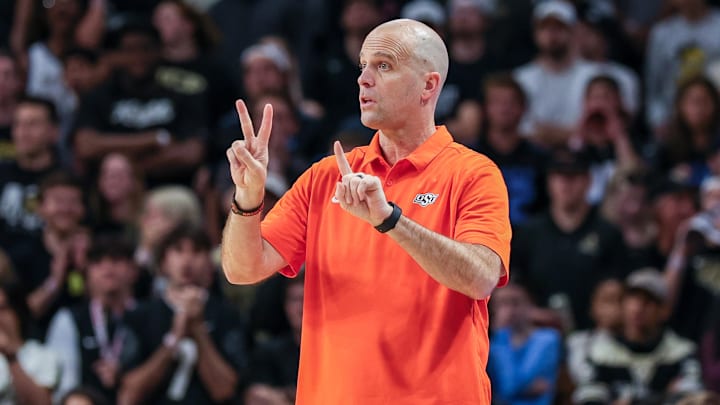First seasons are often “feel‑out” years. Coaches arrive, assess, find out who buys into the culture, and begin establishing norms. The record may not fully reflect the long‑term vision yet. In Year 2, though, things begin to take shape. It’s when a new head coach can start making a statement: this is how my team plays, this is how we operate, this is how we recruit, this is how we win.
That’s the opportunity Steve Lutz now enters at Oklahoma State. After a 17–18 season in 2024–25 and a run in the NIT, Lutz is aiming to build momentum, deepen buy‑in, and make the roster more of his own.
Reflecting on Year 1: Lessons, Promise & Challenges
Lutz’s first year in Stillwater was a transitional campaign. The Cowboys finished just under .500 and made some noise in postseason play with an NIT run. That’s a solid base for a first-year coach trying to install systems, build chemistry, and evaluate personnel.
But with that came the usual growing pains: roster fits weren’t perfect, rotations had to be adjusted midseason, and he had limited opportunity to fully sculpt his roster. The roster at the start of the season was still more inherited than built. Some players were trying to learn new roles; others were simply adapting to a new identity.
Nonetheless, there were bright spots. The team showed fight. There was evidence of Lutz’s desired style: movement, spacing, pace, players who could shoot, pass, handle. Those glimpses provide hope for what might come when more of the pieces align.
Entering Year 2: More Comfortable, More Control
Growing confidence, less uncertainty
One of the key shifts in Year 2 is confidence. In the Pokes Report article, Lutz is noticeably more relaxed and upbeat at official practice media day than he was at the same point a year ago. He stood at the podium happy about the state of his team noting how the early practices and roster developments feel more in his control. He also mentioned having more resources from funding to make NIL offers, and better flexibility in the “golden window” between season end and July 1.
This is not a small thing. When a coach feels more comfortable, the normal distractions of transition fade, and the energy can go toward refinement and accountability.
The roster begins to reflect his vision
One of the most important markers of a head coach’s second season is when the roster begins to look like his roster. That means more of the players he targeted via recruiting or the transfer portal, more alignment with his desired style, and fewer legacy mismatches.
Lutz seems to be heading in that direction. He’s talked about wanting four players on the floor (positions 1‑4) who can pass, handle, and shoot. That’s a lot to ask for but he definitely seems to believe he has the talent on the roster to do so. Last year, there were breakdowns when certain perimeter players couldn’t respond to pressure or spatial defenses. This year, he believes he has more scoring guards and capable wings to balance spacing.
Handling adversity (injuries, chemistry)
Even with more control, second seasons rarely run perfectly. Lutz acknowledged injuries to younger bigs like Mekhi Ragland and Benjamin Ahmed, limiting their availability in early practices. That presents challenges such as rotational strain, slower development, fewer practice reps. If they miss a good amount of time, that could mess with the continuity amongst the team as well, once they do return.
But adversity can also galvanize. Coaches who succeed in Year 2 use constraints as catalysts—forcing role clarity, simplifying schemes, pushing accountability, and accelerating the maturity of the roster.
Furthermore, chemistry and cohesion continue to evolve. New players must adapt to teammates; returning players must embrace new expectations. Lutz’s job is partly to manage that with clarity, consistency, and culture setting.
Conclusion: The Second-Year Moment
Steve Lutz’s second season at Oklahoma State isn’t just about wins and losses — though those will matter. It’s about growth, clarity, culture, and affirming his identity as a head coach. The first year gave a foundation and glimpses of possibility. Now, with more resources, more roster control, and more internal confidence, Lutz has the chance to set the tone, push expectations, and show that this program is heading in a defined direction.
